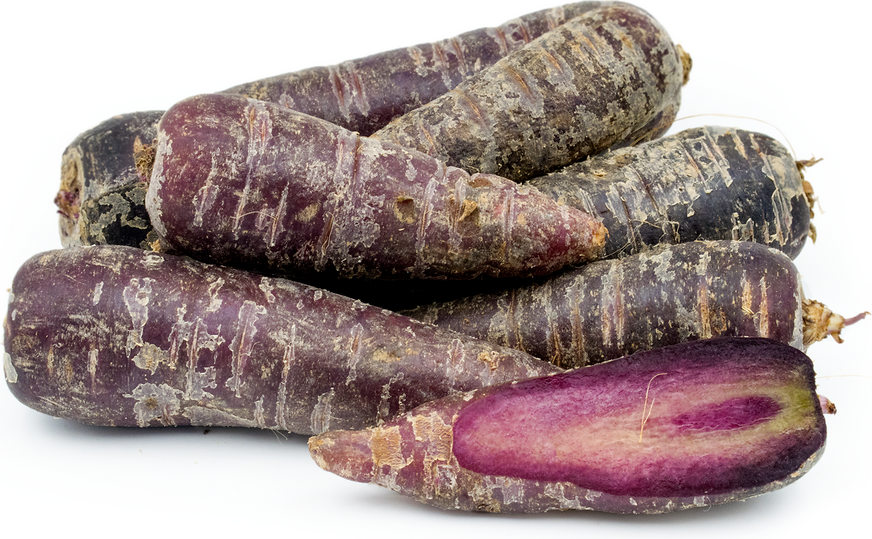


Purple Chantenay Carrots
Estimated Inventory, lb : 0
Description/Taste
Purple Chantenay carrots are small to medium in size, averaging 10-12 centimeters in length and 4-8 centimeters in diameter, and are thick with a stout, conical shape tapering to a blunt point on the non-stem end. The skin is semi-smooth, firm, and dark purple. Underneath the surface, the flesh is dense and crisp with variegated hues of dark and light purple fading into two distinct white streaks in the center. Purple Chantenay carrots have an earthy, pleasantly sweet flavor, and when raw the roots are crunchy, but when cooked, they develop a soft, tender consistency.
Seasons/Availability
Purple Chantenay carrots are available in the late fall through winter.
Current Facts
Purple Chantenay carrots, botanically classified as Daucus carota subsp. Sativus, are rare, seasonal, heirloom roots that belong to the Apiaceae family along with parsnips, celery, and parsley. Indistinguishable from other chantenay carrots in taste, Purple Chantenay carrots are harder to find in the market in comparison to the more common royal and red-cored chantenay varieties. Purple Chantenay carrots are favored by consumers as a specialty variety for the root’s sweet flavor and deep purple hue which stays intact even when cooked.
Nutritional Value
Purple Chantenay carrots contain high amounts of beta carotene, which the human body converts into vitamin A and can help protect eye health. The roots also contain fiber, vitamins C and E, and anthocyanins, which act as antioxidants to protect the overall health of the body and has anti-inflammatory properties.
Applications
Purple Chantenay carrots are best suited for both raw and cooked applications including baking, boiling, steaming, and roasting. These small roots can be used in any recipe that calls for carrots and can also be canned, pickled, or juiced. When raw, Chantenay carrots can be shredded or chopped for green salads, used as a crudité, mixed into grain bowls, or served on vegetable appetizer plates. When cooked, the roots are popularly roasted with pomegranate molasses to create a sweet, tangy, and caramelized side dish. Purple Chantenay carrots can also be sliced and tossed into soups, stews, and curries, braised under roasts, or boiled and served with cooked meats. Purple Chantenay carrots pair well with savory cheeses like pecorino, salty meats like bacon, sweet spreads such as Nutella, creamy dips such as hummus, and fruits such as pomegranate seeds. The roots will keep up to one month when stored loosely placed in a plastic bag with good air circulation in the crisper drawer of the refrigerator. Never store fruit along with carrots, as fruits expel ethylene gas that is readily absorbed by carrots. The carrots exposed to the ethylene gas will turn very bitter, making them not suitable for eating.
Ethnic/Cultural Info
Purple Chantenay carrots are found in Europe, particularly in Britain, where they experienced a revival when Freshgro co-operative, based in Nottinghamshire, began introducing them in stores nation-wide. The CEO of the company, Martin Evans, had worked to reintroduce chantenay carrots to the country since the early 2000s. He then began experimenting with reintroducing the original purple and white varieties. Purple Chantenay carrots first appeared in British stores in 2014 and were one of the most popular vegetables sold in Britain during the Christmas season in 2017.
Geography/History
Purple Chantenay carrots have been present since the 1800s, but they were reintroduced and were made accessible in Britain by Freshgro, also known as Fresh Growers Ltd. Released in late September of 2014, Purple Chantenay carrots have limited availability and are mainly localized to farmers markets and specialty grocers in Europe.
Recipe Ideas
Recipes that include Purple Chantenay Carrots. One
| The Foodie Physician |
|
Barley Salad with Roasted Carrots and Chickpeas |




